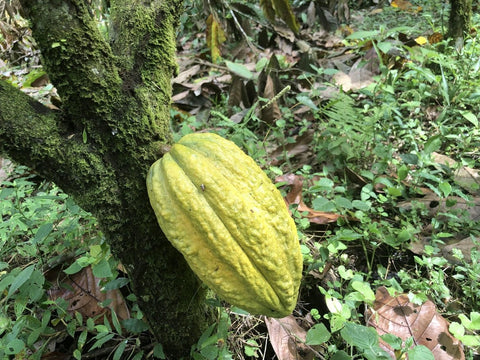Travel to Ecuador #10
Hello my fellow chocolate lovers,
I am Takanori Chiwata, the chocolate engineer of COCONAMA CHOCOLATE.
From now on I would like to talk about the Ecuador trip I had the chance to take the other day. I want to make these posts like my travel journal, so excuse my broken English!
————————————————————————-
That day, we visited Mashupi farm in a town named Mindo. It was two hours drive from Quito towards North-West, and it is the entrance to Amazon.
Monica made us some breakfasts. Hot sandwiches, cheese, ham, bread, yoghurt, and fresh fruit juice. Just how luxurious is that? Fresh fruit juice was a typical breakfast drink in Ecuador.No surprises, I mean, they really do have delicious fruits there.
Jose came to pick us up and off we headed to Mindo. On the way, I felt a little sick. It was probably from altitude sickness, but it wasn’t too big of a deal.
We headed to the mountain as we went passed the Equator Monument.

On the way, we saw a plant that we’ve never seen before. According to Jose, it was coca leaves. You know…coca as in…. Although, I heard that chewing them helps with altitude sickness.
I eventually fell asleep thinking about weird facts about coca leaves.
I woke up because of their deadly heat, and all I saw were a bunch of greens.
That was jungle for you. The heat was really getting bad, and the scenery was completely different too. It really gave off the “tropic zone” vibes with their palm trees.
We were in a place no more than 10°C in the morning, and just driving for an hour or so took us to tropical forest. What an interesting country it was!
As we were all excited, there it was, the good old unpaved road. We held on tightly to the roof handle. Who would’ve thought the day I’d thank the roof handle would come?
Finally, we were at the Mashpi farm. 100km for Quito, and 500m altitude. The heat was deadly, as expected of tropical forest.

When we arrived, we were welcomed by their goat. Followed by dog, then chicken.

Then, their manager Malcom, with a knife in his hand for some reason…You all have no idea how terrifying that was…

A young guy named Andrez from Madrid, Spain showed us around. Of course, with a knife in his hand…

This farm was completely different from the farms we’ve seen previously. It wasn’t like a man-made plantation. Their farm located in the middle of a mountain, so the vibe was completely different.
How different were they though? It was quite thrilling.
We immediately had Andres to show us around the farm. The cacao trees were randomly planted, unlike the previous farms, where it was planted neatly in a row. On top of that, the cacao trees were planted along with citrus fruits trees, banana trees, and others. According to them, planting cacao along with other fruits was they key to delicious cacao.




Was this true though? If it really were to affect the quality, was it the bees? Perhaps the fertilizers? I’m not sure about the truth, but apparently it has a good effect.
They explained about the difference between Nacional and CCN51 as they grew both kinds.
First of all, the shape is different.
The colour is different as well.
Both cacaos are green when they are unripe, but Nacional ripens to yellow, and the CCN51 ripens to orange.


This farm was an organic farm. After the harvest, the shell of cacao pods are left on the ground to return to the soil.

They made their own fertilizer as well. They made their fertilizer by fermenting goats’ and other animals’ waste.

After cracking ripe cacao, they place the contents in a fermentation box.


They covered the box with banana leaves during the process. Banana leaves have a yeast that helps with fermentation.

Then, they mixed the contents once every few days. I had the chance to help out, but just how heavy they were… My weak knees for crying out loud…

The fermentation process runned for 5-7 days, and then they were sun dried.
They had rail attached to the rack, which allowed them to place the rack outside when it was sunny, and move it back inside when it was rainy. Pretty well built!

During the rainy season, they use machines to help the drying process.

The machine looked like this, with many racks inside it.

Mashupi farm had its own brand of chocolate too.

The actual factory was right beside the fermentation and drying section. It was very neat.

Especially their crusher and winnower. I literally wanted to take them home with me.

We finished after experiencing the process of making cacao paste from cacao beans, sugar, and other spices using grain grinder.

We learned a lot from Mashupi farm, along with their organic and self-sufficient farming method. This experience will surely benefit me in the future during workshop and etc.
After our little trip around the farm, we enjoyed our lunch of fried tilapia(yes, although we were up in the mountain), simmered bean, and a fresh juice of banana and citrus fruits. Ecuador food really was something….


When we were just about to head back, we heard that Mindo was famous for humming bird watching. There was no way we’ll miss this!
Just as I was wondering how many of them we’ll get to see, we saw them, millions of them.



We had a very productive day,and when I realized, the day for us to return to Canada was the day after. We went to bed after packing and preparing for our flight back to Vancouver and our visit to the salon du chocolat Ecuador the next day.
————————————————————————-
Let’s call it a day now. See you all on our next post.
With hopes that you will be able to encounter the perfect chocolate just for you,
Takanori Chiwata

